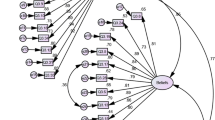Abstract
A series of three studies were conducted to develop and validate a scale to measure violence, harassment, and discrimination toward cross-dressers, transgenderists, and transsexuals. In Study 1, we developed the Genderism and Transphobia Scale (GTS). In Study 2, we established the GTS's ability to predict parents' reactions to either a gender conforming or a gender non-conforming boy or girl. Correlations between the GTS and scales that assess homophobia and gender role ideologies suggest convergent validity. In Study 3, we conducted a factor analysis of the scale, found further evidence of the scale's discriminant and convergent validity, and tested the scale's ability to predict previous contact with gender non-conformists. Taken as a whole, the results of these studies demonstrate the basic psychometric properties of a new and useful scale to measure antipathy toward people who cross genders and sexes.
Similar content being viewed by others
References
Bem, S. (1974). The measurement of psychological androgyny. Journal of Consulting and Clinical Psychology, 42, 155–162.
Coalition for Lesbian and Gay Rights in Ontario. (1997). Systems failure: A report on the experience of sexual minorities in Ontario's health-care and social-services systems. Toronto: Author.
D'Augelli, A. R. (1998). Developmental implications of victimization of lesbian, gay, and bisexual youths. In G. M. Herek (Ed.), Stigma and sexual orientation: Understanding prejudice against lesbians, gay men, and bisexuals (pp. 187–210). Thousand Oaks, CA: Sage.
Eysenck, H. J., & Eysenck, S. B. G. (1975). Manual of the Eysenck Personality Questionnaire. San Diego, CA: EDITS.
Feinberg, L. (1996). Transgender warriors: Making history from Joan of Arc to RuPaul. Boston: Beacon Press.
Franzini, L. R., & Casinelli, D. L. (1986). Health professionals' factual knowledge and changing attitudes toward transsexuals. Social Science and Medicine, 22, 535–539.
Gagné, P., Tweksbury, R., & McGaughey, D. (1996). Coming out and crossing over: Identity formation and proclamation in the transgender community. Gender and Society, 11, 478–508.
Green, R., Stoller, R. J., & MacAndrew, C. (1966). Attitudes toward sex transformation procedures. Archives of General Psychiatry, 15, 178–182.
Haddock, G., & Zanna, M. P. (1998). Authoritarianism, values, and the favorability and structure of antigay attitudes. In G. M. Herek (Ed.), Stigma and sexual orientation: Understanding prejudice against lesbians, gay men, and bisexuals (pp. 82–107). Thousand Oaks, CA: Sage.
Harry, J. (1992). Conceptualizing anti-gay violence. In G. M. Herek & K. T. Berrill (Eds.), Hate crimes: Confronting violence against lesbians and gay men (pp. 113–122). Newbury Park, CA: Sage.
Harvey, J. (2002). Attitudes of the general population toward transsexuals. Unpublished doctoral dissertation, Southern California University for Professional Studies, Santa Ana, CA.
Herek, G. M. (1987). Can functions be measured? A new perspective on the functional approach to attitudes. Social Psychology Quarterly, 50, 285–303.
Herek, G. M. (1993). The context of antigay violence: Notes on cultural and psychological heterosexism. In L. D. Garnets & D. C. Kimmel (Eds.), Psychological perspectives on lesbian and gay male experiences (pp. 89–107). New York: Columbia University Press.
Hill, D. B. (2002). Genderism, transphobia, and gender bashing: A framework for interpreting anti-transgender violence. In B. Wallace & R. Carter (Eds.), Understanding and dealing with violence: A multicultural approach (pp. 113–136). Thousand Oaks, CA: Sage.
Kendel, M., Devor, H., & Strapko, N. (1997). Feminist and lesbian opinions about transsexuals. In B. Bullough, V. L. Bullough, & J. Elias (Eds.), Gender blending (pp. 146–157). New York: Prometheus Books.
Kerr, P. S., & Holden, R. R. (1996). Development of the Gender Role Beliefs Scale. Journal of Social Behavior and Personality, 11, 3–16.
Landen, M., & Innala, S. (2000). Attitudes toward transsexualism in a Swedish national survey. Archives of Sexual Behavior, 29, 375–388.
Leitenberg, H., & Slavin, L. (1983). Comparison of attitudes toward transsexuality and homosexuality. Archives of Sexual Behavior, 12, 337–346.
Lombardi, E. L., Wilchins, R., Priesing, D., & Malouf, D. (2001). Gender violence: Transgender experiences with violence and discrimination. Journal of Homosexuality, 42, 89–101.
Moulton, J. L., III, & Adams-Price, C. E. (1997). Homosexuality, heterosexuality, and cross-dressing: Perceptions of gender discordant behavior. Sex Roles, 37, 441–450.
Namaste, K. (1996). Genderbashing: Sexuality, gender and the regulation of public space. Environmental and Planning D: Society and Space, 14, 221–240.
Neisen, J. H. (1990). Heterosexism: Redefining homophobia for 1990s. Journal of Gay and Lesbian Psychotherapy, 1, 21–35.
Rosenberg, M. (1965). Society and the adolescent self-image. Princeton, NJ: Princeton University Press.
Rye, B. J., & Elmslie, P. (2001a, August). Attitudes toward sexual minorities: Comparisons of ratings of transgender and homosexual persons. Paper presented at the annual meeting of the American Psychological Association, San Francisco, CA.
Rye, B. J., & Elmslie, P. (2001b, June). The Transgender Belief Questionnaire (TBQ): Development and validation. Paper spresented at the annual meeting of the Canadian Psychological Association, Québec City, QC.
Rye, B. J., & Elmslie, P. (2002, November). Attitudes toward transgendered people: Understanding gender diversity. Paper presented to the Annual Meeting of the Society for the Scientific Study of Sexuality, Montréal, QC.
Weinberg, G. (1972). Society and the healthy homosexual. New York: Anchor Books.
Weinberg, M. S., Shaver, F. M., & Williams, C. J. (1999). Gendered sex work in the San Francisco Tenderloin. Archives of Sexual Behavior, 28, 503–521.
Whittle, S. (n.d.). Employment discrimination and transsexual people. Retrieved March 3, 2003, from http://www.gires.org.uk/
Wilchins, R. A. (1997). Read my lips: Sexual subversion and the end of gender. Ithaca, NY: Firebrand Books.
Wright, L. W., Adams, H. E., & Bernat, J. (1999). Development and validation of the Homophobia Scale. Journal of Psychopathology and Behavioral Assessment, 21, 337–347.
Zucker, K. J. (2000). Gender identity disorder. In A. J. Sameroff, M. Lewis, & S. M. Miller (Eds.), Handbook of developmental psychopathology (2nd ed., pp. 671–686). New York: Plenum.
Author information
Authors and Affiliations
Corresponding author
Rights and permissions
About this article
Cite this article
Hill, D.B., Willoughby, B.L.B. The Development and Validation of the Genderism and Transphobia Scale. Sex Roles 53, 531–544 (2005). https://doi.org/10.1007/s11199-005-7140-x
Issue Date:
DOI: https://doi.org/10.1007/s11199-005-7140-x




